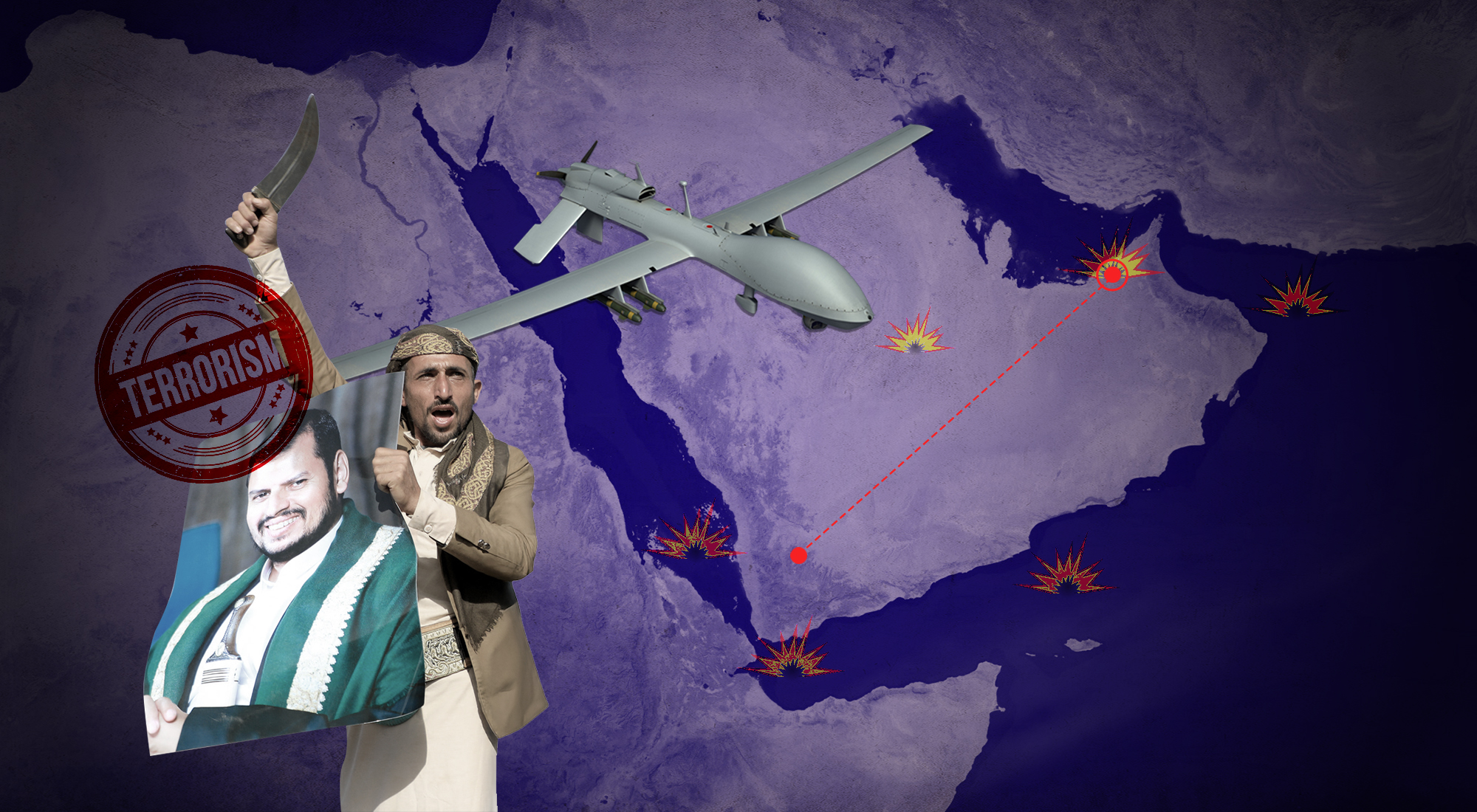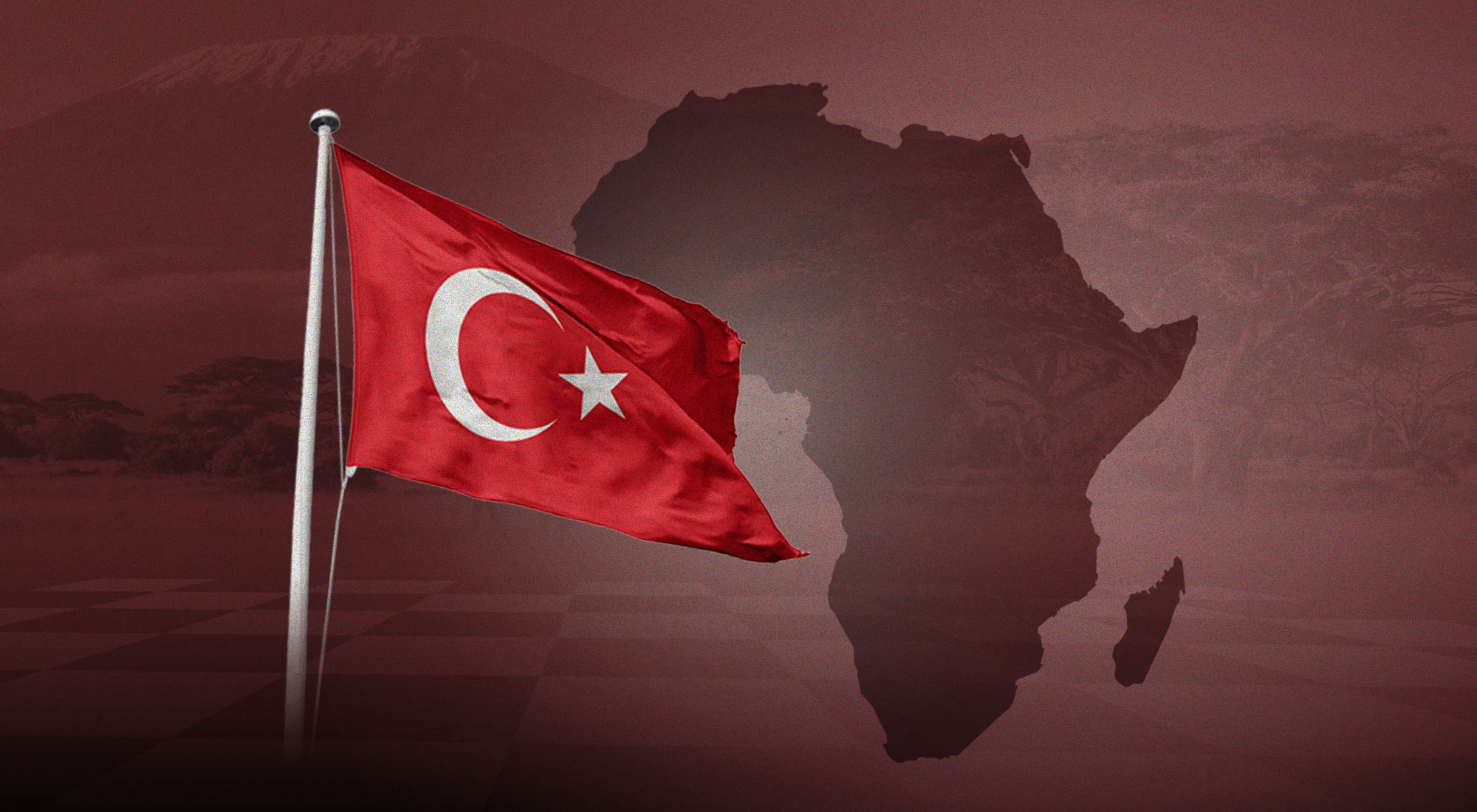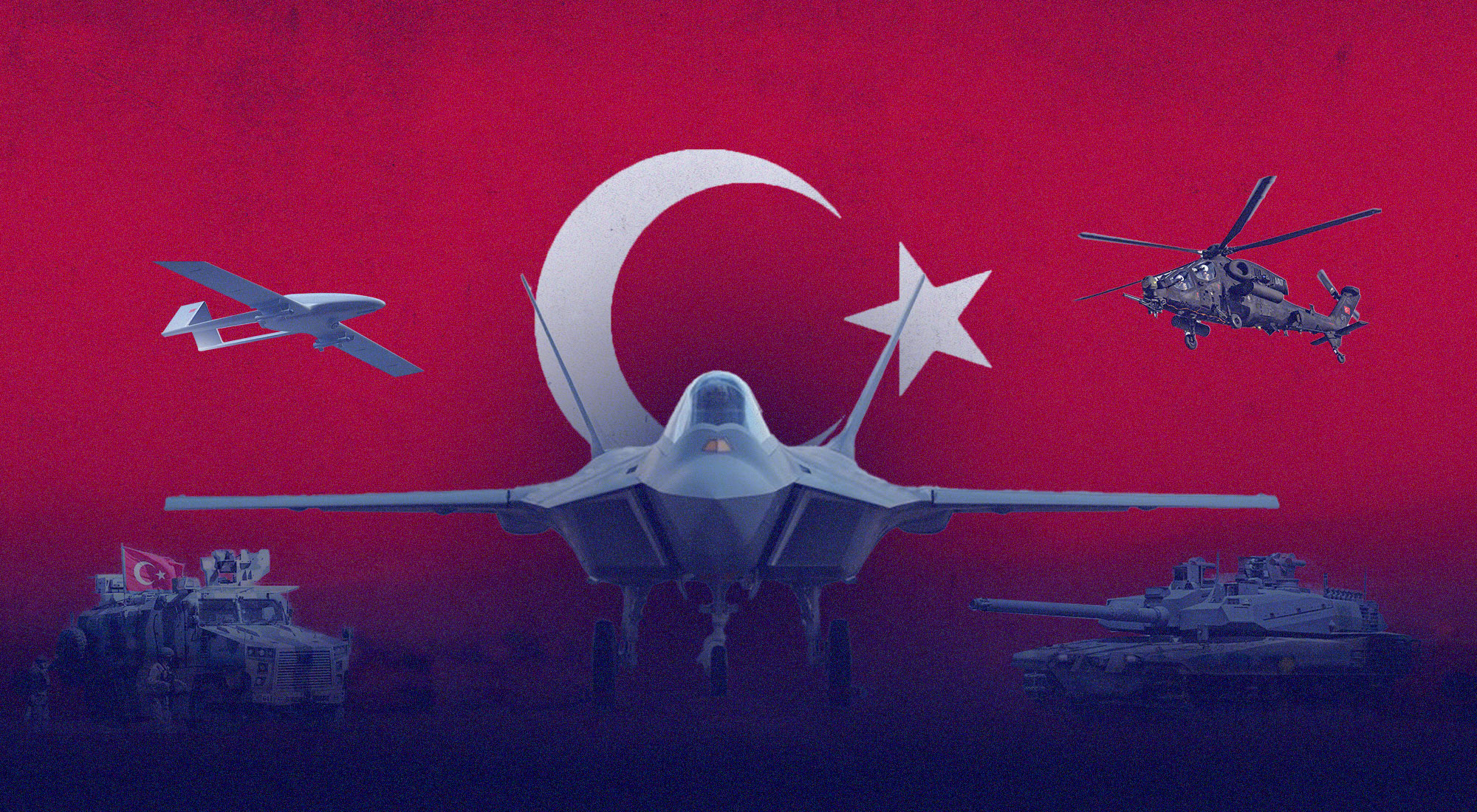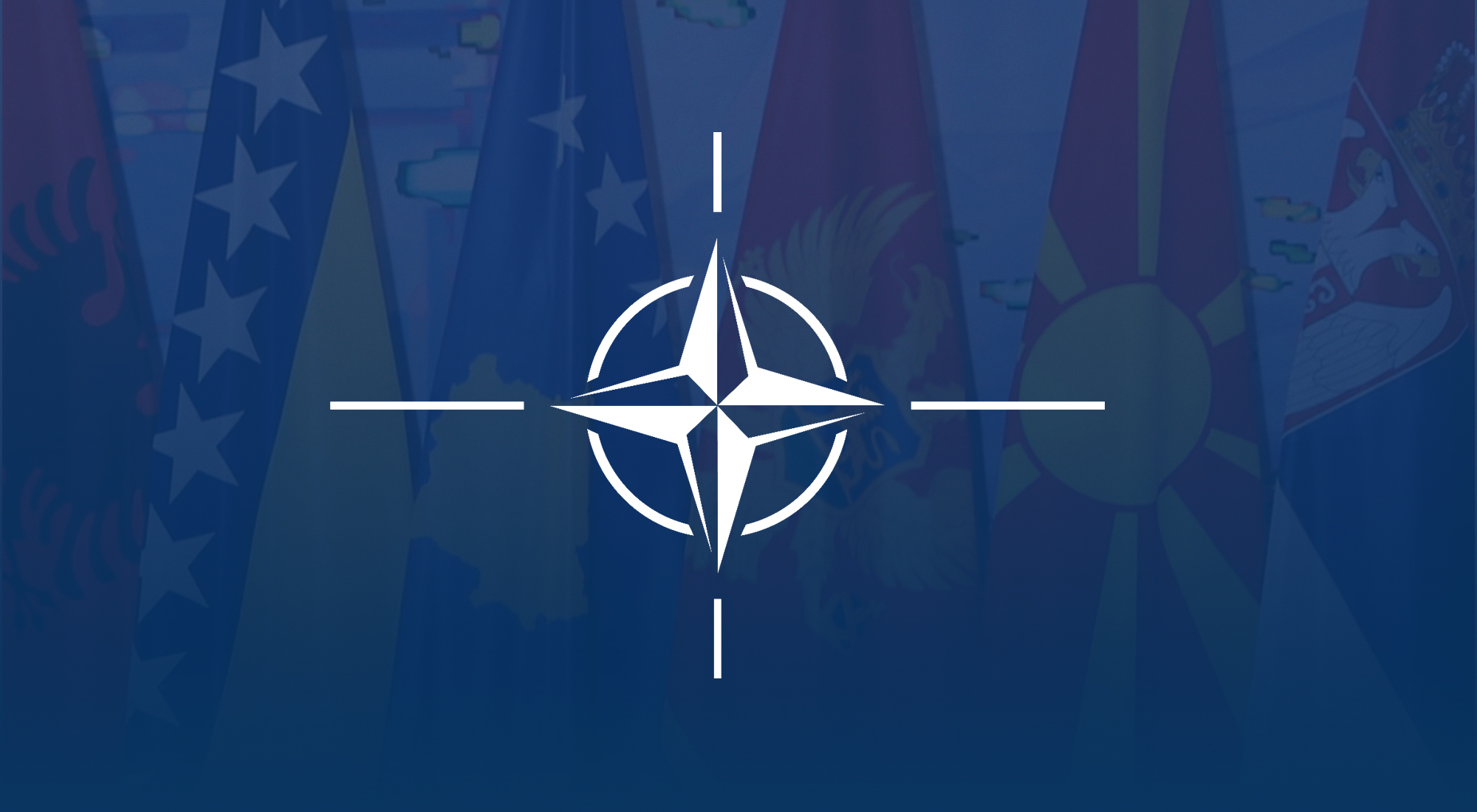Since their coup against Yemen’s legitimate government in 2014, the Houthis have been a key instigator of a prolonged civil war that has now lasted more than a decade, resulting in one of the worst economic and humanitarian crises of modern times. The repercussions of their policies have transcended Yemen’s borders to pose a serious threat to regional security through their engagement with regional alliances and hostile behaviors that directly threaten to destabilize the region.
This study examines the various dimensions of the Houthi threat to regional security by analyzing their role in perpetuating Yemen’s internal conflict and assessing their impact on maritime security in the southern and western Arabian Peninsula. Particular emphasis is given to their direct threats to the security of Gulf Cooperation Council (GCC) countries, citing pivotal incidents such as the attacks on civilian areas and facilities in the UAE on January 17 and 24, 2022. By analyzing these incidents, the study aims to draw valuable lessons to better address similar threats in the future.
First: Background on the Yemeni Conflict and Its Impact on Regional Stability
The roots of Yemen’s civil conflict date back to the Houthis’ coup against the legitimate government in September 2014, their control of the capital, Sana’a, and the subsequent expansion of their control across several Yemeni provinces. This coup sparked a civil war in Yemen, reignited the Southern Issue in the form of an armed movement against Houthi attempts to seize the country, and facilitated the expansion of ISIS and Al-Qaeda in southern Yemen.[1]
In response to a request from Yemen’s legitimate government, the Saudi-led Arab Coalition to Support Legitimacy in Yemen launched “Operation Decisive Storm” in March 2015, carrying out surprise airstrikes targeting airports, military bases, and command-and-control centers seized by the Houthis. By mid-2015, in an operation codenamed “Operation Restoring Hope,” the Arab Coalition, along with Yemeni government forces, Southern Resistance forces, and Northern Resistance forces successfully recaptured Aden, several southern provinces, and parts of Yemen’s western coastline, including the Bab Al-Mandab Strait.[2]
As the civil war spread throughout the country, Yemen’s former president, Ali Abdullah Saleh, announced in 2017 the dissolution of his alliance with the Houthis. This led to fierce clashes between the two sides, culminating in Saleh’s death on December 4, 2017.[3] In 2019, tensions between Yemeni government forces and the Southern Transitional Council (STC) escalated into open conflict. Through Gulf-mediated negotiations, a power-sharing agreement was reached in 2020, resulting in the formation of a coalition government. In April 2022, the Presidential Leadership Council, chaired by Rashad Al-Alimi, was established to govern Yemen from Aden.[4]
After years of intense conflict, the United Nations brokered an “unstable” truce in March 2022, which led to the halt of the Arab Coalition’s operations against the Houthis and a freeze in the frontlines.[5] When the truce ended in October 2022, hostilities did not escalate to “pre-truce levels.” Houthi cross-border attacks on Saudi Arabia ceased, as did the Arab Coalition’s airstrikes on Yemen. This was followed by regional and international efforts to transform the truce into a permanent ceasefire and pave the way for a political resolution.[6] However, a comprehensive peace agreement has yet to be reached, due to Houthi intransigence on a number of negotiation points, such as the prisoner exchange law, the resumption of crude oil exports, and the exclusion of certain competing parties (especially from the southern provinces) from the proposed agreement. Furthermore, political divisions remain among the various factions in Yemen, particularly between the Southern Transitional Council and the Presidential Council.[7]
Yemen still witnesses low-level clashes between the Houthis on one side and the Yemeni government forces and Southern Transitional Council forces on the other. Sporadic terrorist attacks by Al-Qaeda in the Arabian Peninsula also continue, as the group remains active in remote areas. There is coordination between the Houthi group and this terrorist organization.[8]
After over a decade of conflict, Yemen is effectively divided among three main powers: the legitimate government, the Houthi group, and the Southern Transitional Council. Each of them controls different parts of Yemen’s territory, making the map of influence and control complex and overlapping. The territorial boundaries of control are in constant flux due to the ongoing clashes between these factions (see the map below[9]).
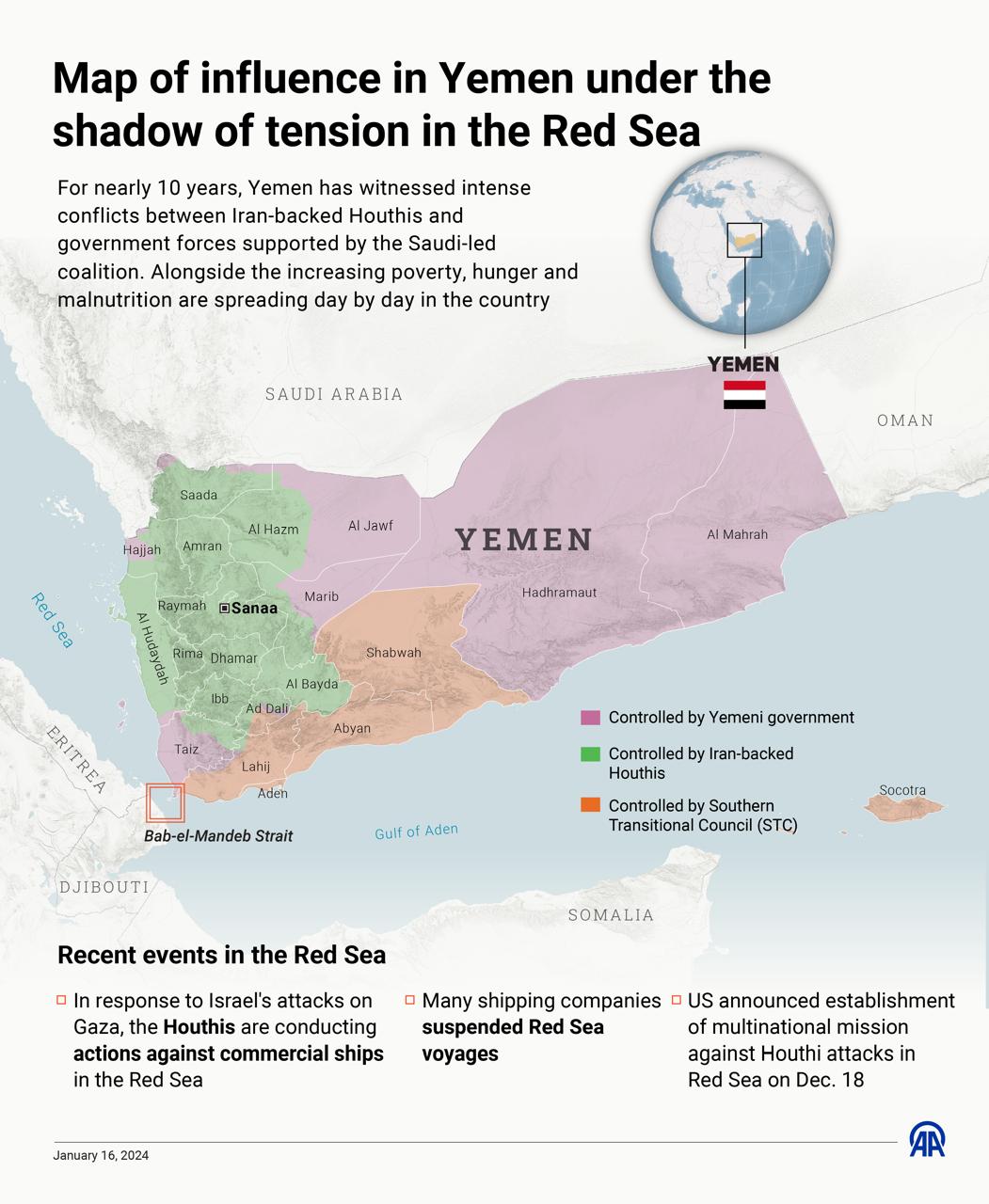
The Houthis have adopted a multifaceted approach to consolidate and expand their control over the territories under their authority. This approach involves military escalation against their opponents, tightening security measures on citizens through forced displacement, crackdown campaigns, arrests, the establishment of new mechanisms and institutions for taxation, confiscation of depositors’ funds, shutting down and demolishing markets, and withholding salaries from government employees. These measures are accompanied by cultural programs designed to reshape Yemeni society in alignment with Houthi ideology.[10]
The conflict in Yemen continues to become increasingly complex due to the involvement of numerous and divergent parties with conflicting interests, as well as external interventions, most notably Iran’s influence and ongoing regional tensions. This situation is further complicated by a political and military deadlock that dominates the current landscape in Yemen.[11]
With efforts to reach an agreement under the UN road map stalled, both the Yemeni government and the Houthi group have resumed military preparations in the midst of unstable regional dynamics. This could lead to a renewed outbreak of war in Yemen. The UN Special Envoy to Yemen, Hans Grundberg, has repeatedly warned of this possibility, highlighting increased military activity, worsening security conditions, and the impact of escalating regional tensions on the fragile peace process.[12]
The conflict in Yemen represents a serious threat to Gulf security and broader regional stability. This threat stems from the possibility of Yemen becoming a failed state on the southern borders of the GCC countries, situated at a vital intersection of international shipping routes through the Bab Al-Mandab Strait and the Suez Canal. With news reports revealing coordination between the Houthi group and Al-Qaeda, alongside the expansion of ISIS in Yemen, there is a likelihood of Yemen turning into a hub for international terrorism. Additionally, the rising influx of refugees complicates border control, enabling the movement of armed groups and smugglers. In 2023, the International Organization for Migration (IOM) reported a surge in cross-border smuggling, which poses a critical risk to border security. Similarly, the Conflict Armament Research (CAR) center has emphasized that arms smuggling across Yemen’s borders threatens the stability of Gulf states, particularly Saudi Arabia and Oman.
One of the most significant threats arising from the Yemeni conflict is the growing Iranian influence in the region. This includes the potential creation of a sectarian “Shiite” state in northern Yemen aligned with Iran, the possible secession of southern Yemen, and the renewed outbreak of civil war between the north and south. The current situation in Yemen poses substantial risks to collective Gulf security, the national security of GCC states, and regional stability as a whole. These threats are further exacerbated by key issues such as illegal migration and smuggling across Yemeni borders, which now endanger Saudi Arabia, Oman, and the UAE.[13] Additionally, Houthi threats to maritime navigation in the Red Sea and surrounding areas intensify these challenges, as will be discussed later.
Second: The UAE’s Participation in the Arab Coalition to Support Legitimacy in Yemen
In September 2014, the UAE rejected the Houthi coup in Yemen and expressed its support for the constitutional legitimacy represented by President Abd-Rabbu Mansour Hadi and his government. The UAE called for a decisive and immediate response to prevent any attempts to change the reality through violence and force. It believes that any resolution to the Yemeni crisis must be based on the terms of the National Dialogue Document, signed in January 2014, as well as the full implementation of the Gulf Initiative (April 2011) mechanisms.[14] Furthermore, the UAE believes that achieving regional security and stability will only be achieved by consolidating the pillars of the national state with its legitimate institutions and confronting terrorist organizations.
The UAE participated in Operation Decisive Storm, which began on March 26, 2015, and lasted for about a month, as part of a Gulf-Arab coalition led by Saudi Arabia. This intervention, requested by Yemeni President Abd-Rabbu Mansour Hadi, aimed to support legitimacy in Yemen and prevent the Houthis from seizing control of the entire country, following their advance southward and their attempt to capture the city of Aden, the stronghold of the Yemeni president. It is noteworthy that the United States declared its political and logistical support for the coalition, while Pakistan pledged to support Saudi Arabia in the event of an attack against it.[15] The UAE was the second most significant country in the coalition in terms of the strength of participation and political and military influence.[16]
The UAE participation in Operation Decisive Storm came in support of the legitimate government and the Yemeni people facing the threat of the Houthi coup and represents a living embodiment of the authentic Emirati Nakhwah )chivalry(. The concept of nakhwah refers to the sum of the virtues of courtesy, generosity, valor, and the ability to endure difficulties in order to help others. That was the role the UAE played in confronting the Houthis.
In April 2015, the Arab coalition announced the transition from the military Operation Decisive Storm to the Operation Restore Hope. By July, the coalition had successfully driven the Houthis and forces loyal to former President Ali Abdullah Saleh out of Aden. The UAE Armed Forces, including special forces, the air force, the navy, and air defense, played a key role in liberating Aden in collaboration with Yemeni resistance forces.[17]
In January 2017, the Yemeni army and popular resistance forces, supported by the Arab coalition, launched a military operation known as Golden Spear to liberate the western coastal cities along the Red Sea and Bab Al-Mandab Strait. In an attempt to retake the city of Hudaydah, government-aligned forces reached the southern parts of the city in June 2018 and laid siege to it. However, the United Nations intervened, leading to a ceasefire in December. This was followed by UN-brokered peace talks between the warring Yemeni parties in Stockholm, resulting in the Stockholm Agreement on Hudaydah (May 2019). The agreement included an immediate ceasefire in Hudaydah province and city, as well as the ports of Hudaydah, Salif, and Ras Issa. It also stipulated the withdrawal of forces from both sides, to be replaced by local authorities, and included provisions for UN monitoring of the city’s ports and aid distribution. However, the ceasefire remained fragile, with both parties accusing each other of violating its terms.[18]
In June 2019, the UAE began to disengage its forces from Yemen to support the ceasefire in Hudaydah.[19] However, after a period of military stalemate coinciding with the peak of the COVID-19 pandemic, the coalition launched a large-scale military operation in January 2022, known as Freedom of Happy Yemen, aimed at crippling the Houthi militia’s capabilities in a number of Yemeni provinces. This was followed by another ‘unstable’ ceasefire in March 2022.[20]
Subsequently, Saudi-Houthi negotiations, mediated by Oman, began in April 2023 to end the Yemeni war.[21] On December 23, 2023, a UN-brokered ceasefire was announced, extending across the entire country, along with measures to improve living conditions and preparations for resuming an inclusive political process under UN auspices.[22]
However, tangible progress remains elusive, and the first official visit by the Houthis to the Saudi capital since the war began, in September 2023, resulted in little more than optimistic statements.[23]
Third: The Houthis and the Threat to International Navigation in the Red Sea and the Gulf of Aden
In November 2023, the Houthis began targeting ships bound for, or linked to, Israel through the Gulf of Aden and the Red Sea in response to the Israeli military actions in Gaza. This escalation prompted the formation of the U.S.-led Operation Prosperity Guardian against the Houthis. Subsequently, U.S. and British ships were also targeted, particularly after U.S. and British air and missile strikes on Houthi-controlled areas. These developments escalated threats to maritime security in the Red Sea and Gulf of Aden to unprecedented levels, turning the region into an active military zone.[24] Houthi attacks on both commercial and military vessels continued, prompting U.S. strikes on Houthi command and control sites, the launch of the European military operation Aspides, and intensified military clashes between Israel and the Houthis.
The Houthis adopted a multifaceted strategy to threaten maritime security, targeting not only commercial and military ships but also conducting military drills in the Red Sea and showcasing advanced weapons such as underwater drones and the “Al-Qari’a” unmanned submarine. Their attacks involved a wide range of modern weapons, including explosive-laden surface vessels (USVs).[25] By mid-2024, the Houthis appeared to expand their operations using different weapons to target Israeli shipping and ports in the Mediterranean Sea, particularly Haifa Port, although this has not yet solidified into a consistent strategy.
Between November 19, 2023, and November 18, 2024, the Houthis carried out approximately 110 attacks on commercial and military ships, imposing new shipping restrictions at various stages of their campaign.[26] They effectively transformed the Bab Al-Mandab Strait into a no-go zone.[27] According to a report by the U.S. Defense Intelligence Agency in June 2024, Houthi attacks in the Red Sea impacted the interests of 65 countries and 29 major energy and shipping companies. The report highlighted growing concerns among sailors, with many refusing to sail through the Red Sea due to persistent Houthi attacks, resulting in a significant decrease in the number of sailors and officers. Reuters interviewed over 15 crew members and shipping industry officials, who confirmed that some shipping companies had rerouted their vessels to avoid the Red Sea, opting instead for the longer and more expensive route around Africa.[28]
In response, the U.S. implemented a counter-strategy involving military, cyber and economic measures. The military aspect included U.S. and British air and missile strikes on Houthi military targets, such as missile platforms, drones, radars and coastal surveillance sites. Cyberattacks aimed to disrupt the Houthis’ intelligence-sharing capabilities, and targeted assassinations of key Houthi figures were carried out in Iraq and Syria, such as the killing of drone expert Hussein Al-Sha’bal. The U.S. also reclassified the Houthis as a Specially Designated Global Terrorist group.
Economic measures included sanctions on individuals, entities, and companies facilitating Houthi financial transactions and arms shipments, as well as Houthi military officials.[29] From January 2024 to January 2025, U.S. and British air and naval strikes on Yemen totaled 931 raids, resulting in 106 fatalities and 314 injuries.
The European military operation Aspides has struggled to counter Houthi escalation effectively due to limited naval capabilities, inadequate air defense systems, high operational costs, and logistical challenges faced by participating countries.[30]
The U.S. is likely to adopt a more complex strategy by pursuing multiple tracks simultaneously, which could ultimately enable it to reach a decisive agreement on this issue within a short period. This approach aims to preempt the escalation of the threat to a new phase, where the Somali-based Al-Shabaab movement could join the Houthis in threatening maritime navigation in the Horn of Africa.
In June 2024, news reports indicated that U.S. intelligence had learned of ongoing discussions between the Houthis and Al-Shabaab for the provision of weapons, including missiles and mortars. However, there is no conclusive evidence so far to confirm that the Houthis have delivered weapons to Al-Shabaab in Somalia.
While the Houthis may have previously drawn confidence from Iranian support, it is likely they will reconsider this stance in light of the fall of the Assad regime in Syria. This shift could create an opportunity to pressure the Houthis to cease their attacks in the Red Sea.[31]
Fourth: Houthi Attack on Abu Dhabi on January 17, 2022
On January 17, 2022, the Houthi militia carried out a terrorist attack involving drones and ballistic missiles targeting critical civilian infrastructure in Abu Dhabi, resulting in civilian casualties and significant material damage.[32] The Houthis employed a dual-strategy attack, simultaneously using drones and ballistic missiles[33] to strike three key locations in the emirate:
– Mussafah Industrial Area (ICAD 3):
A massive explosion occurred in the Mussafah industrial zone, home to fuel storage facilities operated by Abu Dhabi National Oil Company (ADNOC). Investigations revealed that the explosion was caused by three fuel tankers being struck by small drones loaded with explosives, triggering a major fire.[34]
– Abu Dhabi International Airport:
At the same time, the new construction area of Abu Dhabi International Airport was also targeted, resulting in a limited fire. Reports indicated that the attack was caused by a ballistic missile launched from Yemen. Although the fire caused minimal damage, it led to panic among passengers and airport staff.
The attack occurred around 10:00 AM local time, indicating the Houthis’ intent to maximize human and material losses by striking at peak operational hours.[35] The group officially claimed responsibility for the attack, confirming the use of drones and ballistic missiles and threatening to conduct further attacks on UAE territory in the future.[36]
The attack resulted in the death of three civilians—two Indians and one Pakistani—and injured six others with varying degrees of severity. The UAE leadership expressed condolences to the victims’ families and pledged full support for them.
Material losses included extensive damage to fuel tankers in the Mussafah industrial area and other targeted facilities.
On January 24, 2022, the UAE’s air defense systems successfully intercepted two ballistic missiles launched by the Houthis toward Abu Dhabi. The interception prevented any casualties or damage.
UAE’s Response to the Houthi Attack
The UAE’s response was swift and comprehensive, with security forces effectively intercepting and neutralizing incoming projectiles using advanced missile defense systems, significantly reducing the potential for further casualties and damage.
Emergency services were immediately deployed to the affected sites to extinguish fires and secure the areas, preventing additional harm. The National Emergency Crisis and Disaster Management Authority (NCEMA) coordinated efforts across various agencies to ensure a smooth and effective response.
In the hours following the attack, UAE leadership issued strong condemnations, calling for international cooperation to counter the growing Houthi threat. Authorities provided transparent communication to reassure the public about the country’s readiness to handle such crises. The rapid restoration of damaged infrastructure highlighted the UAE’s advanced crisis management capabilities.
The attack also prompted the UAE to enhance its internal security measures, including increasing surveillance and sharing intelligence with allies. The UAE deployed advanced technologies, such as AI-powered monitoring systems, to anticipate and counter potential threats. These measures demonstrated the proactive approach adopted by the UAE to protect its citizens and infrastructure from asymmetric warfare.
Fifth: UAE Diplomatic Response to the January 17 Attack
The UAE’s efforts to address the attack extended beyond security and military measures to include a comprehensive diplomatic campaign across various platforms aimed at mobilizing international support and highlighting the seriousness of the terrorist attack and its regional and global implications.
The UAE immediately engaged with international organizations, particularly the UN, to provide a detailed briefing on the attack and secure a formal condemnation. The UAE government submitted a letter to the UN Security Council, requesting an emergency session to discuss the Houthi attack. In response, the Security Council issued a unanimous statement condemning the attack and calling for accountability for those responsible.[37]
At the same time, the UAE informed the Arab League of the Houthi attack and urged it to take a firm stance against the Houthi militia and their supporters. UAE diplomats also intensified communication with allied and friendly nations, explaining the circumstances of the attack and garnering international support for the UAE’s position.
As part of its diplomatic efforts, the UAE called on the international community to intensify efforts to achieve a political solution to the Yemeni conflict. The UAE emphasized that continued conflict exacerbates humanitarian crises and increases regional security threats.
Simultaneously, the UAE’s diplomacy highlighted Iran’s role in supporting the Houthi militia by providing them with advanced weapons and technology, enabling them to carry out terrorist attacks that threaten regional security and stability. The UAE reiterated its firm stance on combating terrorism in all forms and expressed its commitment to continued cooperation with the international community to eliminate global terrorist threats.
The UAE’s diplomatic response to the Houthi attack on Abu Dhabi was both efficient and professional, achieving several key objectives: securing international condemnation of the terrorist attack; affirming the UAE’s right to self-defense against such threats; raising global awareness of the terrorist threat posed by the Houthis and Iran’s involvement in supporting them; and calling for intensified international efforts to reach a political solution to the Yemeni crisis.
Sixth: International Support for the UAE Following the January 2022 Attack
The Houthi attack on Abu Dhabi triggered a widespread wave of international condemnation, with nations and people around the world expressing solidarity with the UAE in the face of this cowardly act of terrorism. The global response underscored the urgent need to halt Houthi aggression and hold those responsible accountable. This international solidarity was evident in a series of official statements and positions issued by numerous countries and international organizations,[38] all of which reaffirmed their rejection of terrorism in all its forms and expressed support for the UAE’s right to defend its territory and citizens.
The United Nations Security Council unanimously issued a statement condemning the Houthi attack on Abu Dhabi and emphasizing the necessity of bringing the perpetrators to justice. Council members voiced deep concern over the escalating violence in Yemen and urged all parties to uphold the ceasefire and work toward a political resolution to the crisis.[39]
The Arab League also condemned the Houthi attack on the UAE, reaffirming its full solidarity with the country in the face of this assault, which targeted its security and stability. It called on the international community to take a firm stance against the Houthi militia and its supporters, urging action to halt their interference in the internal affairs of Arab nations.[40]
Similarly, the GCC nations expressed their unwavering solidarity with the UAE in response to the Houthi attack, affirming their full support for all measures the UAE takes to defend its territory and citizens. They also emphasized the importance of strengthening security cooperation among GCC nations to counter shared security threats.
Several Arab nations also condemned the Houthi attack and expressed their solidarity with the UAE, emphasizing the need to halt Iran’s support for the Houthi militia. Likewise, many Western countries, including the United States, France, the United Kingdom, and Germany, denounced the attack and reaffirmed their support for the UAE’s right to defend itself. At the same time, these nations voiced concern over the escalating violence in Yemen and called on all parties to cease hostilities and pursue a political resolution to the crisis.
Additionally, several other global powers, including China and Russia, condemned the Houthi attack on the UAE and expressed their solidarity with the country in the face of this aggression.
The overwhelming international support for the UAE following the Houthi attack on Abu Dhabi sent a clear message to the Houthis and their backers: the world unequivocally rejects terrorism in all its forms, and the global community stands firmly with the UAE in its right to defend itself and safeguard its security and stability. These unified positions also underscored the urgent need to intensify international efforts toward a political resolution to the Yemeni crisis and an end to the violence plaguing the country.
Despite the widespread international condemnation of the attack, it also reignited questions about the United States’ commitment to protecting its Gulf allies from Houthi threats and how it could achieve this while opposing the military operations those allies had been conducting against militia positions in Yemen. The Biden administration’s response to the issue was notably cautious.[41] Interestingly, the U.S. did not hesitate to launch strikes against the Houthis after its ships were targeted following the events of October 7, 2023. This contrast highlights Washington’s double standards in dealing with threats to its own direct interests and security threats to its GCC allies.
Seventh: The UAE’s Commitment to Regional Stability and Its Role in Managing Regional and International Conflicts
The UAE’s response to the January 17 attack reaffirmed its commitment to regional stability and its active role in managing and resolving both regional and international conflicts. The country’s robust security infrastructure, coupled with its proactive and pragmatic diplomacy, further cements its standing as a regional leader.[42]
In addition to addressing immediate threats, the UAE remains dedicated to long-term solutions for the Yemeni conflict, advocating for dialogue and inclusive governance. Its efforts to counter the Houthi threat are part of a broader strategy aimed at fostering security and prosperity in the Middle East, positioning the UAE as a key player in global security dynamics. The attack served as a real test of the UAE’s influence in the region, demonstrating its ability to balance decisive security measures with diplomatic leadership. This dual approach has further solidified the UAE’s role as a pivotal force in promoting both regional and global stability.
The UAE’s response to the Houthi attack was a strategic blend of security measures and effective diplomacy, reflecting its unwavering commitment to regional stability. The country demonstrated high efficiency in protecting its infrastructure and citizens, despite escalating security challenges. Its diplomatic efforts were swift and impactful, successfully mobilizing broad international solidarity through statements of condemnation and support from numerous nations and organizations. Additionally, the UAE played a pivotal role in strengthening regional security cooperation, reinforcing its position as a responsible leader capable of addressing shared threats in coordination with regional and global partners.
The UAE’s response to the attack was not limited to self-defense; it also focused on long-term solutions for the Yemeni crisis. The country has consistently emphasized the importance of dialogue and inclusive governance as key mechanisms for conflict resolution, reflecting a balanced vision that goes beyond military responses. The UAE’s strategy for countering the Houthi threat is comprehensive, integrating security measures, developmental support for the Yemeni people, and initiatives for diplomatic solutions. This approach underscores the UAE’s deep understanding of its leadership role in the region and its commitment to achieving lasting peace that ensures regional security and stability.[43]
In fact, the UAE plays a pivotal role in shaping regional and global security policies by strengthening security cooperation and supporting the stability of vital maritime routes. It actively works to build effective security partnerships with GCC nations and major global powers to ensure collective security. Beyond security efforts, the UAE also contributes to economic and social development in Yemen, emphasizing development as a fundamental pillar for achieving lasting peace. Additionally, the UAE’s efforts extend to building international alliances, enhancing its ability to tackle shared challenges, and reinforcing its status as a responsible global power shaping the future of regional and global security.
The UAE’s response to the Houthi attack further demonstrated its role as a strategic global player committed to enhancing international security. By safeguarding vital maritime routes, such as the Red Sea and the Arabian Gulf, the UAE actively contributes to global economic security. Moreover, it maintains an active role in international organizations, helping to advance peace and stability efforts in Yemen. The UAE’s ability to balance decisive security actions with a commitment to dialogue makes it a unique model of a nation that blends strength with moderation. This approach positions the UAE at the forefront of efforts to achieve regional and global stability, leveraging its economic and diplomatic influence in service of international security.
Conclusion
This paper examined the Houthi attacks on civilian facilities and areas in the UAE on January 17 and 24, 2022, as well as the group’s threats to maritime security in the southern and western Arabian Peninsula and its use of sectarian terrorism within Yemen.
The paper concluded that the Houthi group bears full responsibility for the unprecedented political, economic, and humanitarian crisis in Yemen, which has persisted since its 2014 coup against the legitimate government. The prolonged civil conflict has significantly impacted Houthi rule, exposing the group to internal power struggles, deep-rooted corruption, and a growing legitimacy crisis in the territories under its control.
The terrorist attacks of January 17 and 24 highlighted the preparedness and readiness of UAE law enforcement and armed forces to counter any threats to national security. The UAE’s response demonstrated its capability to confront security challenges with a firm and balanced strategy, combining military strength, proactive diplomacy, and a commitment to peaceful solutions. This approach has reinforced the UAE’s strategic position as a leading power in the region, steering it toward stability and security. Moreover, the UAE’s role extends beyond national security, actively influencing regional and global security dynamics, making it an indispensable partner in efforts to achieve peace and development both in the region and beyond. The UAE’s handling of Houthi terrorist attacks underscores its advanced military capabilities, ensuring the safety and security of all residents while maintaining its economic trajectory, which remains resilient and unaffected by such hostile acts.
The policies pursued by the Houthis in Yemen and the broader region have failed. Their strategy aimed to manipulate domestic and Arab public opinion, create international pressure for the recognition of their rule, and undermine the UAE’s reputation as a secure commercial hub. However, their aggressive tactics against the UAE and other GCC states, as well as their threats to maritime navigation, have failed to achieve any of their objectives—whether in gaining sympathy from the Yemeni, Arab, and Islamic public or in weakening their adversaries. Instead, the opposite has happened: the Houthis’ capabilities have been significantly weakened by U.S. and British air and missile strikes under the Operation Prosperity Guardian, as well as Israeli air raids in response to Houthi missile and drone attacks on Israeli cities and sites.
Furthermore, the Houthis’ attempt to rally domestic support by presenting themselves as fighting a battle against external enemies has not only failed disastrously but has also backfired. Reports—based on verified accounts from within Yemen—indicate that the Houthis are struggling to recruit new fighters from northern and southern Yemeni tribes, while their legitimacy crisis continues to deepen.
The Houthis appear to be their own worst enemy. While there was once an international—and possibly even Arab—inclination to integrate the group into Yemen’s political system through a political settlement, the current reality is starkly different: a broad international coalition is now forming to counter their terrorist threat both domestically and beyond Yemen’s borders. If international pressure on Houthi leadership and power centers continues, their already fragile rule may collapse in the near future.[44]
The Houthis’ attacks on Abu Dhabi in 2022 were designed to undermine the UAE’s reputation as a safe commercial hub and to provoke a military confrontation that could deter tourists, businesses, and investors—all of which are key pillars of the UAE’s economic development strategy. However, the failure of this strategy is evident in the continuation of high-profile international events in the UAE, as well as the exceptional preparedness and swift response demonstrated by UAE law enforcement and armed forces in neutralizing such threats.
That said, the terrorist attacks carried out by the Houthi group have serious implications for international security, regional stability, and the safety of vital maritime trade routes. These actions demand a firm international response to curb the Houthis’ growing threat. The international community must fulfill its responsibility by redesignating the Houthi group as a terrorist organization and including it among the key targets in the global fight against terrorism.
[1] The Editors of Encyclopaedia Britannica, “Yemeni Civil War | MAP, Houthi, Saudi Arabia, & Israel,” Encyclopaedia Britannica, January 17, 2024, https://www.britannica.com/event/Yemeni-Civil-War.
[2] “The War in Yemen: A Timeline from the Start of the Conflict to Saudi-Houthi Talks,” BBC, April 11, 2023. https://shorturl.at/SLcYb. [In Arabic]
[3] “The War in Yemen,” BBC. [In Arabic]
[4] Congressional Research Service (CRS), Yemen: Conflict, Red Sea Attacks, and U.S. Policy, October 24, 2024, https://shorturl.at/nGppI.
[5] CRS, Houthi Attacks in the Red Sea: Issues for Congress, CRS Insight, September 06, 2024, IN1230, https://crsreports.congress.gov
[6] CRS, Yemen: Conflict, Red Sea Attacks.
[7] Muhammad Abdul Aati, “Yemen After Ten Years of Civil War and Foreign Interventions,” Al Jazeera Center for Studies, September 18, 2024. https://shorturl.at/w4jwb؛ [In Arabic].
Center for Preventive Action, Conflict in Yemen and the Red Sea, October 08, 2024, https://shorturl.at/RINXE.
[8] CRS, “Yemen: Conflict, Red Sea Attacks.”
[9] Source: “Yemen’s control map amid Red Sea tensions,” Anadolu Ajansı, January 16, 2024, https://www.aa.com.tr/ar/info/İnfografik/37604.
[10] The Editors of Encyclopaedia Britannica, “Yemeni Civil War.”
[11] Abdul Ati, “Yemen After Ten Years”. [In Arabic]
[12] Fakhr Al-Azab, “The Return of the Drums of Civil War in Yemen,” Al-Araby Al-Jadeed, January 2, 2025. https://shorturl.at/OaBsv. [In Arabic]
[13] Anthony Cordesman, “Moving toward Unity: Making Effective Use of Arab Gulf Forces and Resources,” in The Future of Warfare in the 21st Century (Abu Dhabi: The Emirates Center for Strategic Studies and Research, 2014), 229.
[14] Ministry of Foreign Affairs, “Ministry of Foreign Affairs Report on the Occasion of the 43rd National Day of the United Arab Emirates,” December 2014, 15-16. [In Arabic]
[15] “A Gulf Coalition Led by Saudi Arabia Launches Military Operation in Yemen, and Egypt Is Ready to Participate,” BBC, March 26, 2015. https://shorturl.at/aXwWF. [In Arabic]
[16] Nation Shield, “Main Dossier: The Armed Forces… An Effective Role in Enhancing the UAE’s Regional and International Influence,” Issue 520 (May 2015). [In Arabic]
[17] Michael Knights, 25 Days to Aden: The Unknown Story of Arabian Elite forces at War (Profile Editions (GB), 2023).
[18] The Editors of Encyclopaedia Britannica, “Yemeni Civil War.”
[19] Ahmed Nagi, “The Conflict in Yemen Is More Than a Proxy War,” Foreign Affairs, July 21, 2023, https://shorturl.at/Y9jFw.
[20] “The Coalition: The Objectives of ‘Freedom of Happy Yemen’ Operation Are Being Achieved,” Al-Arabiya, January 20, 2022. https://shorturl.at/DeCKN. [In Arabic]
[21] Nagi, “The Conflict in Yemen”.
[22] “The United Nations Announces Agreement Between Yemeni Parties on a Comprehensive Ceasefire,” Al-Sharq, December 23, 2023. [In Arabic]
[23] The Editors of Encyclopaedia Britannica, “Yemeni Civil War.”
[24] “The Houthis: We will target ships heading for Israel, and we warn shipping companies,” Asharq News, December 9, 2023, https://shorturl.at/osoto [Arabic]
[25] Noam Raydan and Farzin Nadimi, “Houthi Shipping Attacks: Patterns and Expectations for 2025,” The Washington Institute for Near East Policy, December 16, 2024, https://shorturl.at/NKavw.
[26] ACELD, “Red Sea Attacks: Interactive Map,” December 12, 2024, https://shorturl.at/uYtfH; Noam Raydan and Farzin Nadimi, “Tracking Maritime Attacks in the Middle East Since 2019,” December 20, 2024, https://shorturl.at/MhANh.
[27] Raydan and Nadimi, “Houthi Shipping Attacks”.
[28] CRS, Houthi Attacks.
[29] CRS, Houthi Attacks.
[30] Ibrahim Jalal, “Operation Aspides, or the Peril of Low Expectations in Yemen,” Carnegie Endowment for International Peace, November 19, 2024, https://shorturl.at/5Xw3A.
[31] Heistein and Rabkin, “After Assad.”
[32] Alarabiya, Targeted by the Houthis: What is the importance of the industrial Mussafah area in the UAE? January 17, 2022. [Arabic]
[33] Al-Otaiba: The Houthis deployed missiles and drones in the Abu Dhabi attack, Sky News Arabia, January 20, 2022, https://shorturl.at/W1Ax7 [Arabic]
[34] WAM, January 17, 2022, https://shorturl.at/HBQo9 [Arabic]
[35] Ministry of Foreign Affairs and International Cooperation, January 18, 2022, https://www.mofa.gov.ae/ar-ae/mediahub/news/2022/1/18/18-01-2022-uae [Arabic]
[36] CNN, January 17, 2022, https://arabic.cnn.com/middle-east/article/2022/01/17/uae-abu-dhabi-attack-0 [Arabic]
[37] WAM, January 18, 2022, https://shorturl.at/reOaD [Arabic]
[38] Al Arabiya, January 24, 2022: https://tinyurl.com/5ehe5s9a [in Arabic]
[39] Al Khaleej, January 21, 2022: https://tinyurl.com/5bu3xyuh [in Arabic]
[40] Sharjah 24, January 23, 2022: https://sharjah24.ae/ar/Articles/2022/01/23/zxc42 [in Arabic]
[41] Elana DeLozier, Houthi Strikes on UAE Open Another Front in Yemen War, The Washington Institute for Near East Policy, January 18, 2022: https://tinyurl.com/wcy9t3rk. [in Arabic]
[42] Al Khaleej, January 20, 2022: https://tinyurl.com/mrxyj972 [in Arabic]
[43] Jonathan Marcus, Will the UAE-Iran Rapprochement be a Victim of the Houthi Attack? BBC Arabic, January 23, 2022: https://www.bbc.com/arabic/middleeast-60096281 [in Arabic]
[44] Heistein and Rabkin, “After Assad.”



